

Compact Muon Solenoid
LHC, CERN
| CMS-PAS-SMP-19-013 | ||
| Measurements of the pp $\to$ W$^{\pm}\gamma\gamma$ and pp $\to$ Z$\gamma\gamma$ cross sections and limits on anomalous quartic gauge couplings at $\sqrt{s} = $ 13 TeV | ||
| CMS Collaboration | ||
| March 2021 | ||
| Abstract: The cross section for W or Z boson production in association with two photons is measured in proton-proton collisions at a centre-of-mass energy of 13 TeV. The dataset corresponds to an integrated luminosity of 137 fb$^{-1}$ collected by the CMS experiment at the LHC. The $\mathrm{W}(\ell\nu)\gamma\gamma$ and $\mathrm{Z}(\ell\ell)\gamma\gamma$ (where $\ell=$ e, $\mu$) cross sections are extracted in the phase space identified by an electron (muon) transverse momentum threshold of 35 (30) GeV and a photon transverse momentum threshold of 20 GeV. The measured cross sections are $\sigma(\mathrm{W}\gamma\gamma) = $ 13.63 $^{+1.93}_{-1.89}$ (stat.) $^{+4.04}_{-4.02}$ (syst.) $\pm$ 0.08 (PDF+scale) fb and $\sigma(\mathrm{Z}\gamma\gamma) = $ 5.41 $^{+0.58}_{-0.55}$ (stat.) $^{+0.64}_{-0.70}$ (syst.) $\pm$ 0.06 (PDF+scale) fb. Limits on anomalous quartic gauge couplings are set in the framework of an effective field theory with dimension-8 operators. | ||
|
Links:
CDS record (PDF) ;
CADI line (restricted) ;
These preliminary results are superseded in this paper, Submitted to JHEP. The superseded preliminary plots can be found here. |
||
| Figures | |
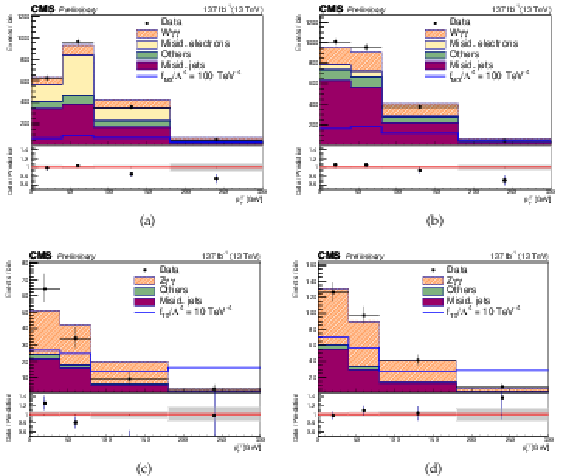
png pdf |
Figure 1:
Distribution of the transverse momentum of the diphoton system for the W$\gamma \gamma $ electron (a) and muon (b) channels and for the Z$\gamma \gamma $ electron (c) and muon (d) channels. In the ratio plot, the grey hashed area is the statistical error on the sum of signal and backgrounds while the uncertainty on the black dots is the statistical uncertainty of the data. The expected distribution for an example value of the anomalous coupling parameters $f_{M3}/\Lambda ^4$ and $f_{T0}/\Lambda ^4$ is also shown in blue. |

png pdf |
Figure 1-a:
Distribution of the transverse momentum of the diphoton system for the W$\gamma \gamma $ electron (a) and muon (b) channels and for the Z$\gamma \gamma $ electron (c) and muon (d) channels. In the ratio plot, the grey hashed area is the statistical error on the sum of signal and backgrounds while the uncertainty on the black dots is the statistical uncertainty of the data. The expected distribution for an example value of the anomalous coupling parameters $f_{M3}/\Lambda ^4$ and $f_{T0}/\Lambda ^4$ is also shown in blue. |

png pdf |
Figure 1-b:
Distribution of the transverse momentum of the diphoton system for the W$\gamma \gamma $ electron (a) and muon (b) channels and for the Z$\gamma \gamma $ electron (c) and muon (d) channels. In the ratio plot, the grey hashed area is the statistical error on the sum of signal and backgrounds while the uncertainty on the black dots is the statistical uncertainty of the data. The expected distribution for an example value of the anomalous coupling parameters $f_{M3}/\Lambda ^4$ and $f_{T0}/\Lambda ^4$ is also shown in blue. |
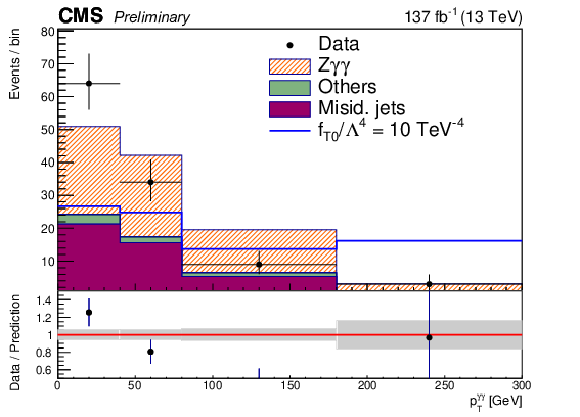
png pdf |
Figure 1-c:
Distribution of the transverse momentum of the diphoton system for the W$\gamma \gamma $ electron (a) and muon (b) channels and for the Z$\gamma \gamma $ electron (c) and muon (d) channels. In the ratio plot, the grey hashed area is the statistical error on the sum of signal and backgrounds while the uncertainty on the black dots is the statistical uncertainty of the data. The expected distribution for an example value of the anomalous coupling parameters $f_{M3}/\Lambda ^4$ and $f_{T0}/\Lambda ^4$ is also shown in blue. |
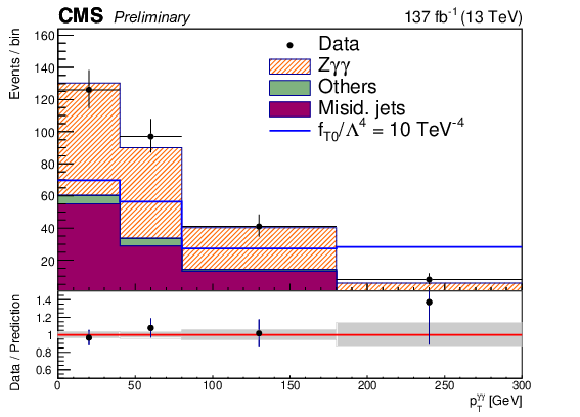
png pdf |
Figure 1-d:
Distribution of the transverse momentum of the diphoton system for the W$\gamma \gamma $ electron (a) and muon (b) channels and for the Z$\gamma \gamma $ electron (c) and muon (d) channels. In the ratio plot, the grey hashed area is the statistical error on the sum of signal and backgrounds while the uncertainty on the black dots is the statistical uncertainty of the data. The expected distribution for an example value of the anomalous coupling parameters $f_{M3}/\Lambda ^4$ and $f_{T0}/\Lambda ^4$ is also shown in blue. |

png pdf |
Figure 2:
Best fit values of the signal strengths for the W$\gamma \gamma $ (left) and the Z$\gamma \gamma $ (right) channels. The error bars represent the total uncertainty. |

png pdf |
Figure 2-a:
Best fit values of the signal strengths for the W$\gamma \gamma $ (left) and the Z$\gamma \gamma $ (right) channels. The error bars represent the total uncertainty. |
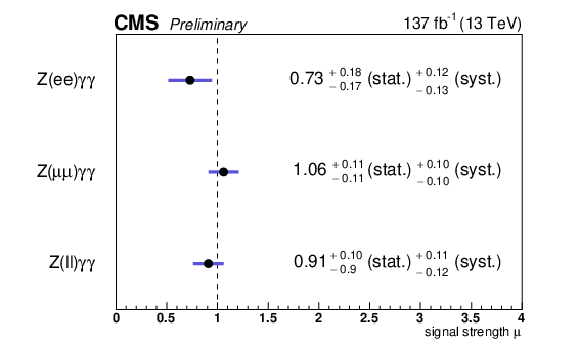
png pdf |
Figure 2-b:
Best fit values of the signal strengths for the W$\gamma \gamma $ (left) and the Z$\gamma \gamma $ (right) channels. The error bars represent the total uncertainty. |
| Tables | |

png pdf |
Table 1:
Summary of the systematic uncertainties (in%) for the W$\gamma \gamma $ and the Z$\gamma \gamma $ cross section measurements. The numbers indicate the impact of each systematic uncertainty on the value of the measured cross section in the corresponding channel. |

png pdf |
Table 2:
Summary of the predicted and observed number of events with the full Run 2 statistics for the W$\gamma \gamma $ selection in the electron and muon channels. The systematic uncertainty on the predicted background and total background categories is obtained by summing the contributions of the different systematic uncertainties. |

png pdf |
Table 3:
Summary of the predicted and observed number of events with the full Run 2 statistics for the Z$\gamma \gamma $ selection in the electron and muon channels. The systematic uncertainty on the predicted background and total background categories is obtained by summing the contributions of the different systematic uncertainties. |
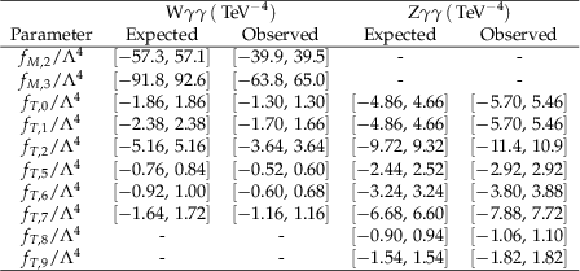
png pdf |
Table 4:
Expected and observed limits for the different anomalous couplings parameters in both the W$\gamma \gamma $ and Z$\gamma \gamma $ channels. |
| Summary |
|
The cross sections for both the W$\gamma\gamma$ and the Z$\gamma\gamma$ processes are measured in proton-proton collision events collected by the CMS experiment at a centre-of-mass energy of 13 TeV corresponding to an integrated luminosity of 137 fb$^{-1}$. The cross sections are measured in a fiducial region where signal Monte Carlo events are selected at generator level in the W$\gamma\gamma$ channel by requiring exactly one electron (muon) with transverse momentum greater than 30 GeV and pseudorapidity smaller than 2.5 and at least two photons with transverse momentum greater than 20 GeV and pseudorapidity smaller than 2.5. Events are selected in the Z$\gamma\gamma$ channel by requiring two oppositely charged electrons (muons), at least one of them with transverse momentum greater than 30 GeV and pseudorapidity smaller than 2.5, and not less than two photons with transverse momentum greater than 20 GeV and pseudorapidity smaller than 2.5. Additionally the invariant mass of the dilepton system is required to be $m_{\ell\ell} > $ 55 GeV. The measured cross sections are 13.63 $^{+1.93}_{-1.89}$ (stat.) $^{+4.04}_{-4.02} $(syst.) $\pm$ 0.08 (PDF+scale) fb for the W$\gamma\gamma$ channel and 5.41 $^{+0.58}_{-0.55}$ (stat.) $^{+0.64}_{-0.70}$ (syst.) $\pm$ 0.06 (PDF+scale) fb for the Z$\gamma\gamma$ channel. These results are in agreement with the theoretical cross sections computed at NLO. The corresponding significance for observing the signal is 3.1$\,\sigma$ and 4.8$\,\sigma$, respectively. Limits on anomalous Quartic Gauge Couplings are set using both channels. |
| References | ||||
| 1 | C. Degrande et al. | Effective Field Theory: A Modern Approach to Anomalous Couplings | Annals Phys. 335 (2013) 21 | 1205.4231 |
| 2 | ATLAS Collaboration | Evidence of $ \mathrm{W}\gamma\gamma $ production in pp collisions at $ \sqrt{s}= $ 8 TeV and limits on anomalous quartic gauge couplings with the ATLAS detector | PRL 115 (2015) 031802 | 1503.03243 |
| 3 | ATLAS Collaboration | Measurements of $ \mathrm{Z}\gamma $ and $ \mathrm{Z}\gamma\gamma $ production in pp collisions at $ \sqrt{s}= $ 8 TeV with the ATLAS detector | PRD 93 (2016) 112002 | 1604.05232 |
| 4 | CMS Collaboration | Measurements of the pp $ \to\mathrm{W}\gamma\gamma $ and pp $ \to \mathrm{Z}\gamma\gamma $ cross sections and limits on anomalous quartic gauge couplings at $ \sqrt{s}= $ 8 TeV | JHEP 10 (2017) 072 | CMS-SMP-15-008 1704.00366 |
| 5 | G. Bozzi, F. Campanario, M. Rauch, and D. Zeppenfeld | $ \mathrm{W^{\pm}}\gamma\gamma $ production with leptonic decays at NLO QCD | PRD 83 (2011) 114035 | 1103.4613 |
| 6 | U. Baur, D. Wackeroth, and M. M. Weber | Radiative corrections to $ \mathrm{W}\gamma\gamma $ production at the LHC | PoS RADCOR2009 (2010) 067 | 1001.2688 |
| 7 | G. Bozzi, F. Campanario, M. Rauch, and D. Zeppenfeld | $ \mathrm{Z}\gamma\gamma $ production with leptonic decays and triple photon production at next-to-leading order QCD | PRD 84 (2011) 074028 | 1107.3149 |
| 8 | CMS Collaboration | The CMS trigger system | JINST 12 (2017) P01020 | CMS-TRG-12-001 1609.02366 |
| 9 | CMS Collaboration | The CMS experiment at the CERN LHC | JINST 3 (2008) S08004 | CMS-00-001 |
| 10 | J. Alwall et al. | The automated computation of tree-level and next-to-leading order differential cross sections, and their matching to parton shower simulations | JHEP 07 (2014) 079 | 1405.0301 |
| 11 | NNPDF Collaboration | Parton distributions for the LHC Run II | JHEP 04 (2015) 040 | 1410.8849 |
| 12 | NNPDF Collaboration | Parton distributions from high-precision collider data | EPJC 77 (2017) 663 | 1706.00428 |
| 13 | T. Gleisberg et al. | SHERPA 1. alpha: A Proof of concept version | JHEP 02 (2004) 056 | hep-ph/0311263 |
| 14 | T. Gleisberg et al. | Event generation with SHERPA 1.1 | Journal of High Energy Physics 2 (2009) 007 | 0811.4622 |
| 15 | P. Nason | A new method for combining NLO QCD with shower Monte Carlo algorithms | JHEP 11 (2004) 040 | hep-ph/0409146 |
| 16 | S. Frixione, P. Nason, and C. Oleari | Matching NLO QCD computations with parton shower simulations: the POWHEG method | JHEP 11 (2007) 070 | 0709.2092 |
| 17 | S. Alioli, P. Nason, C. Oleari, and E. Re | A general framework for implementing NLO calculations in shower Monte Carlo programs: the POWHEG BOX | JHEP 06 (2010) 043 | 1002.2581 |
| 18 | S. Alioli, P. Nason, C. Oleari, and E. Re | NLO single-top production matched with shower in POWHEG: s- and t-channel contributions | JHEP 09 (2009) 111 | 0907.4076 |
| 19 | P. Artoisenet, R. Frederix, O. Mattelaer, and R. Rietkerk | Automatic spin-entangled decays of heavy resonances in Monte Carlo simulations | JHEP 03 (2013) 015 | 1212.3460 |
| 20 | T. Sjostrand et al. | An introduction to PYTHIA 8.2 | CPC 191 (2015) 159 | 1410.3012 |
| 21 | CMS Collaboration | Event generator tunes obtained from underlying event and multiparton scattering measurements | EPJC 76 (2016) 155 | CMS-GEN-14-001 1512.00815 |
| 22 | CMS Collaboration | Extraction and validation of a new set of CMS PYTHIA8 tunes from underlying-event measurements | EPJC 80 (2020) 4 | CMS-GEN-17-001 1903.12179 |
| 23 | C. Degrande et al. | UFO - The Universal FeynRules Output | CPC 183 (2012) 1201 | 1108.2040 |
| 24 | GEANT4 Collaboration | GEANT4 - a simulation toolkit | NIMA 506 (2003) 250 | |
| 25 | CMS Collaboration | Particle-flow reconstruction and global event description with the CMS detector | JINST 12 (2017) P10003 | CMS-PRF-14-001 1706.04965 |
| 26 | CMS Collaboration | Performance of missing transverse momentum reconstruction in proton-proton collisions at $ \sqrt{s} = $ 13 TeV using the CMS detector | JINST 14 (2019) P07004 | CMS-JME-17-001 1903.06078 |
| 27 | CMS Collaboration | Measurement of the inclusive $ \mathrm{W} $ and $ \mathrm{Z} $ production cross sections in pp collisions at $ \sqrt{s} = $ 7 TeV with the CMS experiment | JHEP 10 (2011) 132 | CMS-EWK-10-005 1107.4789 |
| 28 | O. J. P. Éboli, M. C. Gonzalez-Garcia, and J. K. Mizukoshi | $ {\mathrm{p}}{\mathrm{p}}\to\mathrm{jj}\mathrm{e^{\pm}}\mu^{\pm}\nu\nu $ and $ \mathrm{jj}\mathrm{e^{\pm}}\mu^{\mp}\nu\nu $ at $ \mathcal{O}(\alpha_\mathrm{em}^6) $ and $ \mathcal{O}(\alpha_\mathrm{em}^4\alpha_\mathrm{s}^2) $ for the study of the quartic electroweak gauge boson vertex at CERN LHC | PRD 74 (2006) 073005 | hep-ph/0606118 |

|
Compact Muon Solenoid LHC, CERN |

|

|

|

|

|

|